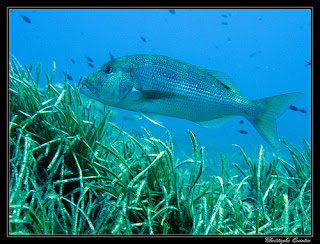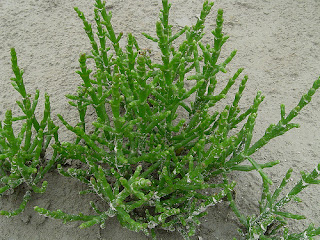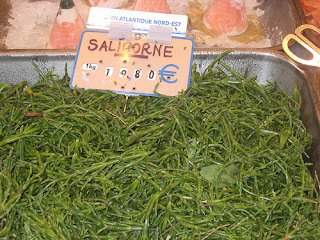from
Behind the French Menu
by
Bryan G. Newman
behindthefrenchmenu@gmail.com
Dentex
Dentex from the sea.
When caught in the wild the dentex will have come to your menu via the Mediterranean or the Atlantic. Nevertheless, fish under 600 grams will have come from fish-farms. In the wild, dentex can reach 15 kilos or more, but they are rarely seen over six kilos.
Dentex in the Mediterranean I.
Dentex on French Menus:
Pavé de Denti Sauce Vierge –- A thick cut of this fish served with sauce vierge. (See the appendix Sauces: Sauce Vierge).
Denti de la Pêche Corse Rôti –- Wild dentex from the Corsican coasts, served grilled.
Carpaccio de Denti – Dentex Carpaccio.
Pave de Denti aux Girolles – A large cut of dentex prepared with girolle chanterelle mushrooms.
Denti au Four. (Minimum 4 pers) – Roasted dentex, for a minimum of four persons. This will be a single fish weighing over one kilo; probably one and a half kilos. Deboned that will be close to 250 grams of fish per diner.
Dentex in the Mediterranean II.
Photograph courtesy of Christophe Quintin
Denti de Méditerranée Rôti, Fricassée de Girolles aux Abricots et Salicornes – Dentex, from the Mediterranean, roasted and served with a fricassee, a stew, of girolle chanterelle mushrooms, apricots, and salicornes. Salicornia or samphire is often, mistakenly, called an edible seaweed; it is not. Salicorne, of which there are many family members, grows in salt marshes and along the coast, not in the sea. The young salicorne plants are collected between April through July and then will be used in salads, sauces, soups.
Dentex with cuttlefish ink.
There are quite a number of close dentex family members, and they will all find their way to the menu under the one name, dentex.
Dentex in the languages of France’s neighbors:
(Catalan - dentó), (Dutch - tandbrasem), (German – zahnbrasse), (Italian- dental, dendichi, dentice), (Spanish - dentón, déntol).
Connected Posts:
Behind the French Menu
by
Bryan G. Newman
behindthefrenchmenu@gmail.com
Copyright 2016





















